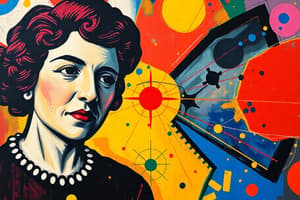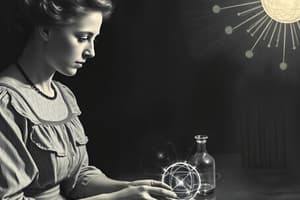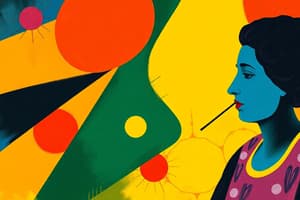Podcast
Questions and Answers
What significant contribution to medical science, unrelated to angiography, is attributed to Moniz?
What significant contribution to medical science, unrelated to angiography, is attributed to Moniz?
- Invention of prefrontal lobotomy. (correct)
- Pioneering research in nuclear fission.
- Discovery of new treatments for spinal injuries.
- Development of early brain scanning techniques.
In what year did Lise Meitner move to Berlin to work as a departmental assistant at Max Planck's physics institute?
In what year did Lise Meitner move to Berlin to work as a departmental assistant at Max Planck's physics institute?
- 1938
- 1917
- 1901
- 1907 (correct)
What event significantly impacted Moniz's career and physical health in 1939?
What event significantly impacted Moniz's career and physical health in 1939?
- He was shot by a patient, resulting in a shattered spine. (correct)
- He published his seminal work on angiography.
- He contracted a severe illness, limiting his practice.
- He received the Nobel Prize, increasing his recognition.
Prior to her scientific breakthroughs, what educational opportunity was Lise Meitner afforded that was uncommon for girls at the time?
Prior to her scientific breakthroughs, what educational opportunity was Lise Meitner afforded that was uncommon for girls at the time?
What was the specific circumstance that prompted Lise Meitner's escape from Nazi Germany in 1938?
What was the specific circumstance that prompted Lise Meitner's escape from Nazi Germany in 1938?
What was the primary focus of Lise Meitner's doctoral thesis?
What was the primary focus of Lise Meitner's doctoral thesis?
What crucial realization did Lise Meitner have regarding Hahn's 1938 experiment, leading to the understanding of nuclear fission?
What crucial realization did Lise Meitner have regarding Hahn's 1938 experiment, leading to the understanding of nuclear fission?
What role did Niels Bohr and Dirk Coster play in Lise Meitner's life during the 1930s?
What role did Niels Bohr and Dirk Coster play in Lise Meitner's life during the 1930s?
What key development did Enrico Fermi achieve in 1942, building upon the work of Meitner and Frisch?
What key development did Enrico Fermi achieve in 1942, building upon the work of Meitner and Frisch?
Which of the following best describes Meitner's contributions to nuclear fission IMMEDIATELY after fleeing to Sweden?
Which of the following best describes Meitner's contributions to nuclear fission IMMEDIATELY after fleeing to Sweden?
Flashcards
Angiography
Angiography
The process of imaging blood vessels using X-rays after injecting a contrast dye.
Prefrontal lobotomy
Prefrontal lobotomy
A neurosurgical procedure that involves severing connections in the brain's prefrontal cortex, invented by Moniz.
Lise Meitner
Lise Meitner
A physicist who coined the term 'nuclear fission' and explained uranium nucleus splitting.
Nobel Prize 1949
Nobel Prize 1949
Signup and view all the flashcards
Berlin Research
Berlin Research
Signup and view all the flashcards
Nuclear Fission
Nuclear Fission
Signup and view all the flashcards
Otto Hahn
Otto Hahn
Signup and view all the flashcards
Enrico Fermi
Enrico Fermi
Signup and view all the flashcards
Einstein's Theory of Relativity
Einstein's Theory of Relativity
Signup and view all the flashcards
Study Notes
Scientists and Their Discoveries
- Moniz (1874-1955): Began vascular imaging experimentation in 1902. Published first angiography paper in Revue Neurologique (1927). Received Nobel Prize for prefrontal lobotomy (1949)
Scientists and Their Discoveries
- Lise Meitner (1878–1968): Coined the term "nuclear fission" and the theory behind uranium atom splitting. Awarded Leibniz Medal and head of physics section at University of Berlin (1917). Fled Nazi Germany in 1938. Published theory of nuclear fission with Otto Frisch in Nature (1939), along with Hahn and Strassman received the 1966 Enrico Fermi Award. Nominated for the Nobel Prize 48 times between 1924 and 1965. Became first female physics professor in Germany (1926)
Scientists and Their Discoveries
- Enrico Fermi (1901–1954): Created the first working nuclear chain reactor in 1942. Achieved nuclear fission in 1934. Developed nuclear power with physicists' group following the 1939 fission breakthrough.
Scientists and Their Discoveries
- Albert Einstein (1879–1955): Developed general and special theories of relativity (transformed space, time, and gravity). Published four landmark scientific papers in 1905, including those on photoelectric effect and Brownian motion. Published "General Theory of Relativity" (1915). Received Nobel Prize in 1921. Emigrated to the US in 1933. Advocated for peace, signed the Russell-Einstein Manifesto (1955).
Scientists and Their Discoveries
- S. N. Bose (1894–1974): Wrote on photon behavior (1924), influencing Einstein's prediction of a fifth state of matter (Bose-Einstein condensate). Scientists made BEC particles in 1995.
Scientists and Their Discoveries
- Alfred Wegener (1880–1930): Proposed the theory of continental drift. Published theory of continental drift (1912). Published The Origin of Continents and Oceans (1915). Developed theory that continents were once a single land mass (Pangaea). Died on expedition to Greenland (1930).
Scientists and Their Discoveries
- Marie Tharp (1920–2006): Charted the ocean floor. Made remarkable discovery of mid-Atlantic ridge (1953), supporting continental drift theory.
Scientists and Their Discoveries
- Wilhelm Conrad Röntgen (1845–1923): Discovered X-rays (1895) and was awarded the first Nobel Prize in Physics (1901). Gave prize money to scientific research.
Scientists and Their Discoveries
- Kitasato Shibasaburō (1853–1931): Developed serum therapy for tetanus and diphtheria. Discovered injections of tetanus serum confer immunity (1890).
Scientists and Their Discoveries
- Ivan Pavlov (1849–1936): Studied digestive secretions in dogs. Discovered classical conditioning (1904), winning Nobel Prize (1904).
Scientists and Their Discoveries
- Henri Poincaré (1854–1912): Mathematical physicist, studied chaotic behavior in systems, laid groundwork for chaos theory (1908). Wrote papers on electromagnetism, impacting Einstein's work.
Scientists and Their Discoveries
- J. J. Thomson (1856–1940): Described the structure of atoms, identified electrons (corpuscles) via cathode ray tube. Created the plum pudding model. Confirmed existence of isotopes.
Scientists and Their Discoveries
- Svante Arrhenius (1859–1927): Explored the link between human activity and rising global temperatures. Explored ice ages and the causes of increased global warming through fossil fuels (late 1890s).
Scientists and Their Discoveries
- Annie Jump Cannon (1863–1941): Leading authority on star spectra. Developed a standard for photographic measurements (1901). Classified 350,000 stars.
Scientists and Their Discoveries
- Harriet Brooks (1876–1933): Canada's first female nuclear physicist. Studied under J. J. Thomson and Ernest Rutherford. Discovered one element changing into another through nuclear decay (early 1900s).
Scientists and Their Discoveries
- Srinivasa Ramanujan (1887–1920): Made major contributions to mathematical analysis and number theory (little formal training). Invited to Cambridge (1913). Recipient of a Bachelor of Science degree (1916) .
Scientists and Their Discoveries
- Henrietta Swan Leavitt (1868–1921): Studied variable stars (pulsating stars) and their brightness patterns. Her work was crucial to measure distances to other galaxies (Harvard College Observatory).
Scientists and Their Discoveries
- Erwin Schrödinger (1887–1961): Developed the wave equation, revolutionizing our understanding of particle behavior, especially electrons. Developed wave mechanics and helped form the basis for quantum mechanics.
Scientists and Their Discoveries
- Ronald Aylmer Fisher (1890–1962): British statistician and geneticist. Pioneered the application of statistics in scientific experimentation. reconciled Charles Darwin's and Gregor Mendel's ideas.
Scientists and Their Discoveries
- Harold Urey (1893–1981) and Stanley Miller (1930–2007): Simulated early Earth conditions to show how simple life-giving compounds could be produced; experimented with electrical sparks to mimic lightning to study early Earth's chemical composition (1953).
Scientists and Their Discoveries
- Francis Crick (1916–2004): Jointly discovered the structure of DNA with James Watson (1953).
Scientists and Their Discoveries
- James Watson(1928-): Jointly discovered the structure of DNA with Francis Crick (1953). Led the Human Genome Project.
Scientists and Their Discoveries
- Sydney Brenner (1927–2019): Saw Watson and Crick's DNA model early. Did research into developmental genetics and molecular biology. Jointly received a Nobel Prize (2002) for work on organ development and apoptosis.
Scientists and Their Discoveries
- Rosalind Franklin (1920–1958): British chemist. Produced groundbreaking image of DNA (Photograph 51—1952), crucial to the discovery of DNA's double helix structure.
Scientists and Their Discoveries
- Maurice Wilkins (1916–2004): Biophysical studies that helped determine DNA's structure. Shared Nobel Prize with James Watson and Francis Crick (1962).
Scientists and Their Discoveries
- Frederick Sanger(1918-2013): Sequenced proteins, including insulin (1955) and then developed the dideoxy method of DNA sequencing (called Sanger Sequencing). Shared Nobel Prize in Chemistry (1980).
Scientists and Their Discoveries
- John Sulston (1942–2018): First director of the Wellcome Sanger Institute; shared the 2002 Nobel Prize for work on programmed cell death focusing on Caenorhabditis elegans, a worm.
Scientists and Their Discoveries
- Richard Feynman (1918–1988): Exceptional physicist and inspirational teacher. Developed Feynman diagrams to improve quantum electrodynamics (QED) theory (1948) resulting in a more successful and widely accepted theory in physics. Published Feynman Lectures on Physics. Jointly received the Nobel Prize in Physics (1965).
Scientists and Their Discoveries
- Murray Gell-Mann (1929–): Proposed a model for classifying subatomic particles, inventing the "quark." His model, known as the standard model, was accurate and is widely used. Received the 1969 Nobel Prize.
Scientists and Their Discoveries
- Henry Stommel (1920–1992): Oceanographer. Explained powerful forces in ocean currents, including the Gulf Stream. Created the theory of global ocean circulation (late 1940s). Awarded the United States National Medal of Science (1989).
Scientists and Their Discoveries
- Chen-Ning Yang (1922–): Theoretical physicist. Questioned conservation of parity and showed how it was not correct in weak interactions (1956). Contributed to the "Yang-Mills theory" along with Robert Mills (1954). Jointly received the Nobel Prize in Physics (1957)
Scientists and Their Discoveries
- Benoît Mandelbrot (1924–2010): Founded fractal geometry, visualizing complexities and irregularities in data, with applications in many fields.
Scientists and Their Discoveries
- Ernest McCulloch (1931–): Hematologist. Discovered stem cells with James Till in 1961 that transformed cancer research through bone marrow transplant. Shared the Albert Lasker Award and was inducted into Canadian Science and Engineering Hall of Fame.
Scientists and Their Discoveries
- James Till (1931–): Physicist. Collaborated with Ernest McCulloch in discovering stem cells, which were crucial to bone marrow transplant research.
Scientists and Their Discoveries
- Shinya Yamanaka (1962–): Reengineered mature cells into stem cells. Developed "induced pluripotent stem cells" (iPS cells) – jointly received the Nobel Prize in 2012.
Scientists and Their Discoveries
- Tu Youyou (1930–): Chinese pharmacologist. Isolated artemisinin, major malaria treatment (1970s). Received Nobel Prize (2015), first Chinese woman to win Nobel Prize in Medicine.
Scientists and Their Discoveries
- Satoshi Omura (1935-): Microbiologist. Discovered ivermectin, antiparasite medicine (important for diseases such as river blindness and elephantiasis). Awarded Nobel Prize (2015) together with Tu Youyou and William Campbell.
Scientists and Their Discoveries
- Jane Goodall (1934–): Primatologist. Studied chimpanzee behavior for over 55 years and made important discoveries about their intelligence, socialization and tool use. Founded the Jane Goodall Institute.
Scientists and Their Discoveries
- Valentina Tereshkova (1937-): Became first woman in space (1963). Served in government positions.
Scientists and Their Discoveries
- Patricia Bath (1942-): American ophthalmologist. Developed the Laserphaco Probe for more precise cataract removal (1986).
Scientists and Their Discoveries
- Stephen Hawking (1942–2018): Theoretical physicist. Revealed nature of black holes and explored the origin of the Universe, and how black holes evaporate (Hawking Radiation). Published A Brief History of Time.
Scientists and Their Discoveries
- Jocelyn Bell Burnell (1943-): Discovered pulsars.
Scientists and Their Discoveries
- Tak Wah Mak (1946–): Immunologist and molecular biologist. Discovered how T-cells recognize antigens.
Scientists and Their Discoveries
- Tim Berners-Lee (1955-): Computer scientist. Invented the World Wide Web (WWW). Proposed HTML and HTTP (1991).
Scientists and Their Discoveries
- Fred Hoyle (1915–2001): Worked on the origin of elements in stars. Proponent of the steady-state theory of the universe.
Scientists and Their Discoveries
- Katherine Johnson (1918–): Calculated trajectories for space missions, including those of Alan Shepard, the first American in space. Worked for NACA/NASA.
Scientists and Their Discoveries
- Irene Uchida (1917–2013): Medical geneticist. Studied how genes and chromosomes affect health, including genetic diseases like Down Syndrome.
Scientists and Their Discoveries
- Yvonne Brill (1924–2013): Invented propulsion systems for stationary spacecraft; worked on thrusters for weather satellites and rocket designs used in Moon missions. Worked for NASA.
Scientists and Their Discoveries
- Abdus Salam (1926–1996): Proposed the electroweak theory, explaining how weak and electromagnetic forces interact. Received Nobel Prize in Physics (1979).
Scientists and Their Discoveries
- Vera Rubin (1928–2016): Astronomer. Discovered that stars in outer spiral galaxies move as fast as those closer to the center, implying the existence of dark matter.
Scientists and Their Discoveries
- Peter Higgs(1929-): Developed a theory to explain the mass of elementary particles. Predicted the existence of a particle that became known as the Higgs boson. Shared Nobel Prize (2013).
Scientists and Their Discoveries
- Eric Kandel (1929-): Investigated the cellular basis of behavior. Won the Nobel prize(2000) for work related to synapses and memory and learning using the sea slug (Aplysia)
Scientists and Their Discoveries
- Mario Molina (1943-): Investigated that CFCs destroy the ozone layer. Jointly received Nobel Prize in Chemistry (1995).
Scientists and Their Discoveries
- Lap-Chee Tsui (1950-): Identified the gene responsible for cystic fibrosis, creating a crucial stepping stone in new cystic fibrosis treatments.
Scientists and Their Discoveries
- Mae Jemison (1956-): First African-American woman in space. Served as a science mission specialist.
Scientists and Their Discoveries
- **Donna Strickland (1959 - ):**Pioneered work using lasers in the field of physics.
Scientists and Their Discoveries
- J. C. R. Licklider (1915-1990): Early champion of computer power. Commissioned ArpaNet. Licklider was an early force in computing and the internet.
Studying That Suits You
Use AI to generate personalized quizzes and flashcards to suit your learning preferences.





